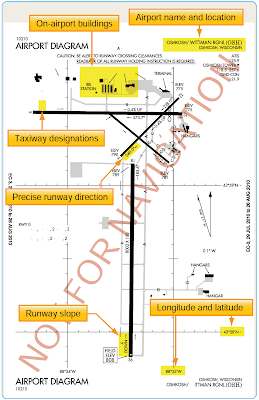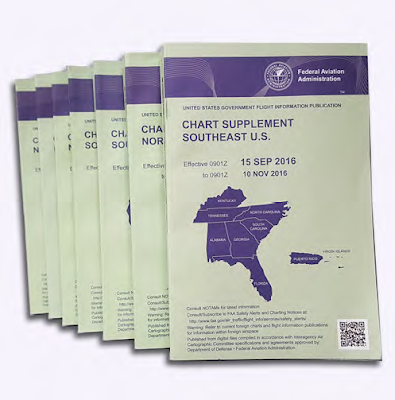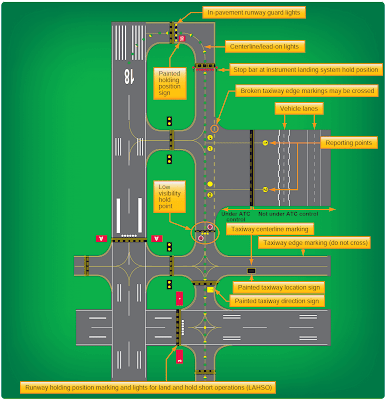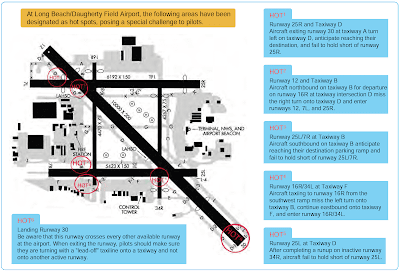One of the biggest safety concerns in aviation is the surface movement accident. As a direct result, the FAA has rapidly expanded the information available to pilots, including the addition of taxiway and runway information in FAA publications, particularly the IFR U.S. Terminal Procedures Publication (TPP) booklets and the Chart Supplement (CS) volumes. The FAA has also implemented new procedures and created educational and awareness programs for pilots, ATC, and ground operators. By focusing resources to attack this problem head on, the FAA hopes to reduce and eventually eliminate surface movement accidents.
Airport Sketches and Diagrams
Airport sketches and diagrams provide pilots of all levels with graphical depictions of the airport layout. Aeronautical Information Services, formerly known as Aeronautical Products (AeroNav), provide an airport sketch on the lower left or right portion of every instrument approach chart. [Figure 1] This sketch depicts the runways, their length, width and slope, the touchdown zone elevation, the lighting system installed on the end of the runway, and taxiways. Graphical depictions of NOTAMS are also available for selected airports as well as for temporary flight restriction (TFRs) areas on the defense internet NOTAM service (DINS) website.
 |
| Figure 1. Airport diagram included on the Oshkosh, Wisconsin VOR RWY 9 Approach Chart as depicted in the IFR TPP |
For select airports, typically those with heavy traffic or complex runway layouts, Aeronautical Information Services also prints an airport diagram. The diagram is located in the IFR TPP booklet following the instrument approach chart for a particular airport. It is a full page depiction of the airport that includes the same features of the airport sketch plus additional details, such as taxiway identifiers, airport latitude and longitude, and building identification.
The airport diagrams are also available in the Airport/Facility Directory section of the Chart Supplement (CS) and on the Aeronautical Information Services’ website, located at www.aeronav.faa.gov. [Figure 2]
Chart Supplements (CS)
In recent years, the former Airport/Facility Directory (A/ FD) booklet was incorporated as a section in the Chart Supplement (CS). [Figure 3] The Chart Supplement (CS) is published by Aeronautical Information Services in regional booklets and online at:[https://www.faa.gov/ air_traffic/flight_info/aeronav/digital_products/dafd/] The online version is known as the digital Chart Supplement (d-CS). The d-CS and the CS are identical and provide textual and graphic information about all airports, both Visual Flight Rules (VFR) and IFR. The Airport/Facility Directory (A/FD) section of the CS includes runway length and width, runway surface, load bearing capacity, runway slope, runway declared distances, airport services, and hazards, such as birds and reduced visibility. [Figure 4] Sketches of airports also are being added to aid VFR pilots in surface movement activities. In support of the FAA Runway Incursion Program, full page airport diagrams and “Hot Spot” locations are included in the A/FD section of the CS. These charts are the same as those published in the IFR TPP and are printed for airports with complex runway or taxiway layouts.
 |
| Figure 4. Excerpts from the Chart Supplement (Airport Facility Directory section) of Naples Muni, Naples, Florida |
Surface Movement Guidance Control System (SMGCS)
The Surface Movement Guidance Control System (SMGCS) was developed to facilitate the safe movement of aircraft and vehicles at airports where scheduled air carriers were conducting authorized operations. Advisory Circular 120-57 was developed in 1992. In 2012, FAA Order 8000.94, Procedures for Establishing Airport Low-Visibility Operations and Approval of Low-Visibility Operations/Surface Movement Guidance and Control System Operations, was published to provide procedures for establishing Airport Low-Visibility Operations (LVO) and Surface Movement Guidance and Control Systems. It established the necessary FAA headquarters and operating services, roles, responsibilities, and activities for operations at 14 CFR Part 139 airports using RVRs of less than 1,200 feet for each runway. The order applies to all users of the system at all levels who are formally listed. The FAA requires the commissioning of an “FAA approved LVO/ SMGCS Operation” for all new Category III ILS supported runways. Since there are no regulatory takeoff minimums for 14 CFR Part 91 operations, the information provided by FAA AC 120-57 and FAA Order 8000.94 must be understood so that the general aviation pilot can understand LVO and SMGCS during day or night.
The SMGCS low visibility taxi plan includes the enhancement of taxiway and runway signs, markings, and lighting, as well as the creation of SMGCS visual aid diagrams. [Figure 5] The plan also clearly identifies taxi routes and their supporting facilities and equipment. Airport enhancements that are part of the SMGCS program include, but are not limited to:
- Controllable Stop bars lights—these consist of a row of red, unidirectional, in-pavement lights that can be controlled by ATC. They provide interactions with and aircraft that prevent runway incursions during takeoff operations. These are required for operations at less than 500 ft RVR.
- Non-Controllable Stop bars lights—these are red, unidirectinoal lights place at intersections where a restriction to movement is required. They must be in continuous operation at less than 500 ft RVR.
- Taxiway centerline lead-on lights—guide ground traffic under low visibility conditions and at night. These lights consist of alternating green/yellow in-pavement lights.
- Runway guard lights—either elevated or in-pavement, may be installed at all taxiways that provide access to an active runway. They consist of alternately flashing yellow lights. These lights are used to denote both the presence of an active runway and identify the location of a runway holding position marking.
- Geographic position markings—ATC verifies the position of aircraft and vehicles using geographic position markings. The markings can be used either as hold points or for position reporting. These checkpoints or “pink spots” are outlined with a black and white circle and designated with a number or a number and a letter.
- Clearance bar lights—three yellow in-pavement clearance bar lights used to denote holding positions for aircraft and vehicles. When used for hold points, they are co-located with geographic position markings.
Both flight and ground crews, Part 121 and 135 operators, are required to comply with SMGCS plans when implemented at their specific airport. All airport tenants are responsible for disseminating information to their employees and conducting training in low visibility operating procedures. Anyone operating in conjunction with the SMGCS plan must have a copy of the low visibility taxi route chart for their given airport as these charts outline the taxi routes and other detailed information concerning low visibility operations. These charts are available from private sources outside of the FAA. Government sources for SMGCS charts may be available in the future. Part 91 operators are expected to comply with the guidelines listed in AC 120-57, and should expect “Follow Me” service (when available) when low visibility operations are in use. Any SMGCS outage that would adversely affect operations at the airport is issued as a Notice to Airmen (NOTAM).
Advanced Surface Movement Guidance Control System (A-SMGCS)
With the increasing demand for airports to accommodate higher levels of aircraft movements, it is becoming more difficult for the existing infrastructure to safely handle greater capacities of traffic in all weather conditions. As a result, the FAA is implementing runway safety systems, such as Airport Surface Detection Equipment-Model X (ASDE-X) and Advanced Surface Movement Guidance and Control System (A-SMGCS) at various airports. The data that these systems use comes from surface movement radar and aircraft transponders. The combination of these data sources allows the systems to determine the position and identification of aircraft on the airport movement area and decreases the potential of collisions on airport runways and taxiways.
Additional information concerning airport lighting, markings, and signs can be found in the Aeronautical Information Manual (AIM) and the Pilot’s Handbook of Aeronautical Knowledge, appendix 1, as well as on the FAA’s website at http://www.faa.gov/airports/runway_safety/.
Airport Signs, Lighting, and Markings
Flight crews use airport lighting, markings, and signs to help maintain situational awareness. These visual aids provide information concerning the aircraft’s location on the airport, the taxiway in use, and the runway entrance being used. Overlooking this information can lead to ground accidents that are entirely preventable. If you encounter unfamiliar markings or lighting, contact ATC for clarification and, if necessary, request progressive taxi instructions. Pilots are encouraged to notify the appropriate authorities of erroneous, misleading, or decaying signs or lighting that would contribute to the failure of safe ground operations.
Runway Incursions
On any given day, the NAS may handle almost 200,000 takeoffs and landings. Due to the complex nature of the airport environment and the intricacies of the network of people that make it operate efficiently, the FAA is constantly looking to maintain the high standard of safety that exists at airports today. Runway safety is one of its top priorities. The FAA defines a runway incursion as: “Any occurrence at an aerodrome involving the incorrect presence of an aircraft, vehicle, or person on the protected area of a surface designated for the landing and takeoff of aircraft.”
The four categories of runway incursions are listed below:
- Category A—a serious incident in which a collision was narrowly avoided.
- Category B—an incident in which separation decreases and there is a significant potential for collision that may result in a time critical corrective/ evasive response to avoid a collision.
- Category C—an incident characterized by ample time and/or distance to avoid a collision.
- Category D—an incident that meets the definition of runway incursion, such as incorrect presence of a single vehicle/person/aircraft on the protected area of a surface designated for the landing and takeoff of aircraft but with no immediate safety consequences.
Figure 6 highlights several steps that reduce the chances of being involved in a runway incursion.
In addition to the SMGCS program, the FAA has implemented additional programs to reduce runway incursions and other surface movement issues. They identified runway hotspots, designed standardized taxi routes, and instituted the Runway Safety Program.
Runway Hotspots
ICAO defines runway hotspots as a location on an aerodrome movement area with a history or potential risk of collision or runway incursion and where heightened attention by pilots and drivers is necessary. Hotspots alert pilots to complex or potentially confusing taxiway geometry that could make surface navigation challenging. Whatever the reason, pilots need to be aware that these hazardous intersections exist, and they should be increasingly vigilant when approaching and taxiing through these intersections. These hotspots are depicted on some airport charts as circled areas. [Figure 7] The FAA Office of Runway Safety has links to the FAA regions that maintain a complete list of airports with runway hotspots at http://www.faa.gov/airports/runway_safety.
Standardized Taxi Routes
Standard taxi routes improve ground management at high-density airports, namely those that have airline service. At these airports, typical taxiway traffic patterns used to move aircraft between gate and runway are laid out and coded. The ATC specialist (ATCS) can reduce radio communication time and eliminate taxi instruction misinterpretation by simply clearing the pilot to taxi via a specific, named route. An example of this would be Los Angeles International Airport (KLAX), where North Route is used to transition to Runway 24L. [Figure 8] These routes are issued by ground control, and if unable to comply, pilots must advise ground control on initial contact. If for any reason the pilot becomes uncertain as to the correct taxi route, a request should be made for progressive taxi instructions. These step-by-step routing directions are also issued if the controller deems it necessary due to traffic, closed taxiways, airport construction, etc. It is the pilot’s responsibility to know if a particular airport has preplanned taxi routes, to be familiar with them, and to have the taxi descriptions in their possession. Specific information about airports that use coded taxiway routes is included in the Notices to Airmen Publication (NTAP).
Taxi and Movement Operations Change
As of June 30, 2010, controllers are required to issue explicit instructions to cross or hold short of each runway that intersects a taxi route. Following is a summary of these procedural changes:
- “Taxi to” is no longer used when issuing taxi instructions to an assigned takeoff runway.
- Instructions to cross a runway are issued one at a time. Instructions to cross multiple runways are not issued. An aircraft or vehicle must have crossed the previous runway before another runway crossing is issued. This applies to any runway, including inactive or closed runways.
- Never cross a runway hold marking without explicit ATC instructions. If in doubt, ask!
Reminder: You may not enter a runway unless you have been:
- Instructed to cross or taxi onto that specific runway;
- Cleared to take off from that runway; or
- Instructed to line up and wait on that specific runway.
For more information on the change, refer to FAA Order JO 7110.65, Air Traffic Control, which can be found at www.faa.gov.






